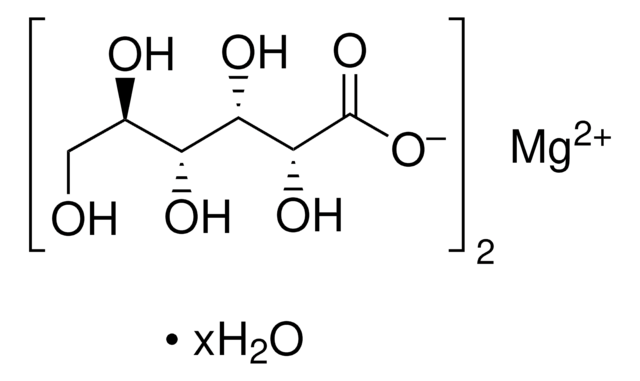W325201
β-Alanine
≥98%, FG
Synonym(s):
β-Ala, 3-Aminopropionic acid
Sign Into View Organizational & Contract Pricing
All Photos(1)
About This Item
Linear Formula:
NH2CH2CH2COOH
CAS Number:
Molecular Weight:
89.09
FEMA Number:
3252
Beilstein:
906793
EC Number:
MDL number:
UNSPSC Code:
12164502
PubChem Substance ID:
Flavis number:
17.001
NACRES:
NA.21
grade:
FG
Halal
Halal
biological source:
synthetic
food allergen:
no known allergens
Recommended Products
biological source
synthetic
grade
FG
Halal
reg. compliance
EU Regulation 1334/2008 & 872/2012
Assay
≥98%
mp
202 °C (dec.) (lit.)
application(s)
flavors and fragrances
Documentation
see Safety & Documentation for available documents
food allergen
no known allergens
Organoleptic
odorless
SMILES string
NCCC(O)=O
InChI
1S/C3H7NO2/c4-2-1-3(5)6/h1-2,4H2,(H,5,6)
InChI key
UCMIRNVEIXFBKS-UHFFFAOYSA-N
Looking for similar products? Visit Product Comparison Guide
Biochem/physiol Actions
Endogenous β-amino acid that is a nonselective agonist at glycine receptors and a ligand for the G protein-coupled orphan receptor, TGR7 (MrgD). β-Alanine is a component of pantothenic acid.
β-Alanine, a β−amino acid, is a component of pantothenic acid and the rate-limiting amino acid in the biosynthesis of the histidinyl antioxidant dipeptides carnosine and anserine. Endogenous β-amino acid that is a nonselective agonist at glycine receptors and a ligand for the G protein-coupled orphan receptor, TGR7 (MrgD). β-Alanine flux plays a cytoprotective role by supporting the osmotic stability of marine organisms, preimplantation mouse embryos and mammalian cells exposed to hypoxic stress.
Storage Class Code
13 - Non Combustible Solids
WGK
WGK 1
Flash Point(F)
Not applicable
Flash Point(C)
Not applicable
Personal Protective Equipment
dust mask type N95 (US), Eyeshields, Gloves
Choose from one of the most recent versions:
Already Own This Product?
Find documentation for the products that you have recently purchased in the Document Library.
Robert G Hart et al.
The Canadian journal of cardiology, 29(7 Suppl), S71-S78 (2013-06-29)
Chronic kidney disease (CKD) is prevalent in elderly patients with atrial fibrillation and is an independent risk factor for stroke. Warfarin anticoagulation is efficacious for stroke prevention in atrial fibrillation patients with moderate CKD (stage III, estimated glomerular filtration rate
Ramin Artang et al.
The American journal of cardiology, 112(12), 1973-1979 (2013-10-01)
Dabigatran has been associated with greater risk of myocardial infarction (MI) than warfarin. It is unknown whether the increased risk is unique to dabigatran, an adverse effect shared by other oral direct thrombin inhibitors (DTIs), or the result of a
K M Gibson et al.
Journal of neurochemistry, 81(1), 71-79 (2002-06-18)
Metabolite profiling in succinate semialdehyde dehydrogenase (SSADH; Aldh5a1-/-) deficient mice previously revealed elevated gamma-hydroxybutyrate (GHB) and total GABA in urine and total brain and liver extracts. In this study, we extend our metabolic characterization of these mutant mice by documenting
Julie Y Culbertson et al.
Nutrients, 2(1), 75-98 (2010-01-01)
Muscle carnosine has been reported to serve as a physiological buffer, possess antioxidant properties, influence enzyme regulation, and affect sarcoplasmic reticulum calcium regulation. Beta-alanine (β-ALA) is a non-essential amino acid. β-ALA supplementation (e.g., 2-6 grams/day) has been shown to increase
Partha Sardar et al.
The American journal of cardiology, 113(7), 1173-1177 (2014-02-12)
Dabigatran is a novel oral anticoagulant and may be useful during atrial fibrillation (AF) ablation for prevention of thromboembolic events. However, the benefits and adverse effects of periprocedural dabigatran therapy have not been thoroughly evaluated. A meta-analysis was performed to
Our team of scientists has experience in all areas of research including Life Science, Material Science, Chemical Synthesis, Chromatography, Analytical and many others.
Contact Technical Service







